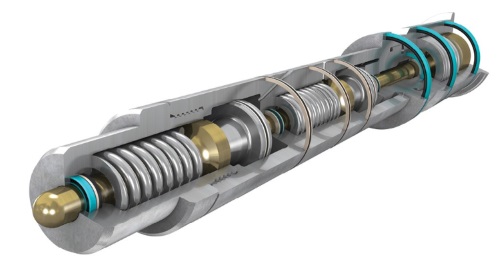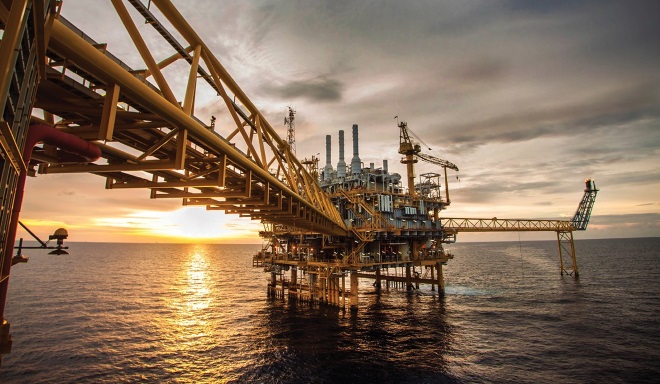By Eric Bucci- Oil & Gas Segment Manager, Trelleborg Sealing Solutions
Hydraulic systems in marine environments require a complex combination of specialized seals. Understanding the different materials and styles is critical to a safe, successful design.
Hydraulic applications are challenging to seal. Not only must the hydraulic seals prevent leakage of fluid from the cylinder, but they must also withstand high pressures, extreme temperatures and transverse forces within the cylinder. The function of hydraulic seals goes far beyond preventing fluid leakage.
Hydraulic systems are not sealed with one seal, rather a complex combination of specialized seals. Hydraulic rod seals prevent leakage of fluid from within the cylinder to the outside, while hydraulic piston seals prevent fluid from flowing across the cylinder head. This allows pressure build-up on one side of the piston, making the cylinder extend or retract. Wear rings guide the piston and piston rod within the hydraulic cylinder, absorbing transverse forces and preventing metal-to-metal contact. Scrapers—also called wipers—scrape dirt, foreign particles, chips or moisture from the piston rods as they retract into the cylinder, preventing contamination.
Special considerations for offshore sealing
The same principles apply to hydraulic sealing, whatever the application, but offshore sealing systems must stand up to extreme pressures, destructive process chemicals and marine environments. In addition, sealing materials need to meet industry standards such as API and NORSOK, while being able to respond to an ever-changing technological horizon. As wells become deeper and processing more aggressive, the working conditions for seals and bearings become more demanding. Avoidance of downtime is a key aspect as the costs associated with this can be huge in the oil industry.
Close collaboration between operators, equipment and sealing suppliers is vital in ensuring long seal life and minimized downtime. One of the most important factors in successful seal specification is understanding the conditions in which equipment will operate. This way, the sealing system can be matched to specific requirements in terms of pressure, temperature and most significantly, media compatibility. Process chemicals can destroy seal materials if not correctly specified.

Downhole tools require solutions that withstand extreme temperatures and aggressive media. Offering extended life, they allow oil and gas extraction from the lowest depths where reliability and lock-free operations are critical. This tool incorporates both the V-stack and Glyd Ring from Trelleborg Sealing Solutions.
In terms of materials, there are many options—from basic acrylonitrile butadiene polymer (NBR) to perfluoroelastomer (FFKM) compounds such as Isolast, a material that has the elasticity of an elastomer and compatibility of a PTFE, or to polytetrafluoroethylene-based seals, which are inherently compatible with virtually all media as well as polyethylenes.
Not only are the materials of seals important, but also their geometries, as each seal within a hydraulic sealing configuration has a specific job to do. The geometries, which have evolved and been enhanced over many years based on application experience, allow the seals to provide a specific function within the sealing system to meet the varying demands of differing applications. For instance, downhole tools need solutions that withstand extreme temperatures and aggressive media. They require a sealing system to give extended life to allow oil and gas extraction from the lowest depths. Reliability and leak-free operation are critical. For tensioner cylinders, a 20-year or longer maintenance-free seal life is designed to prevent downtime and loss of revenue. In hydraulic swivels, increasing speeds and pressures call for innovative seal designs that give low-friction operation.
Select proven solutions
A wide range of proven sealing options is available to the oil and gas industry. Elastomer materials must be carefully selected to meet temperature requirements and be compatible with system media. For the offshore industry, elastomers are usually used with other materials such as PTFE-based compounds; the elastomer provides the elasticity and the PTFE provides low-friction properties. In high-pressure dynamic sealing applications, elastomers can be supported with PEEK (polyetheretherketone) anti-extrusion rings.
The V-stack, for instance, is a multi-component rod seal using multiple chevrons or “Vees” to produce a high integrity seal with multiple redundancy points. These are typically used in rod or piston sealing on downhole tools, particularly on hydraulic setting tools for packers or plugs where conditions are challenging. V-stacks can cope with high temperature and pressure, especially when combined with unknown hardware conditions or “blind stab” applications. The seal can have several Vees in differing materials, usually mated with PEEK anti-extrusion and adapter rings. This results in a proven and robust sealing option.
The Glyd Ring is good for a double-acting seal, primarily on hydraulic pistons, but also as a rod seal. In its compact design, an elastomer component provides a pre-tensioning element to maintain low-pressure sealing integrity, while a PTFE-based or polyethylene sealing component gives the seal low-friction performance. The seal design is well suited to coping with large tolerances or axial loads exerted on the cylinder.
Enhanced over several generations and in multiple industries, the hydraulic Turcon Stepseal II is used for rod or piston sealing and is usually fitted in pairs to produce a “back pumping” effect, reducing leakage and maximizing sealing performance. A further development specifically engineered for the oil and gas industry is the Turcon Stepseal Anti-tilt; an excellent choice for use in tensioner systems. This seal is also available in wear-resistant Zurcon polyethylene compounds for use in low-lubricity, water glycol hydraulic fluids.
Metal springs can offer an alternative to elastomers for providing elasticity. Spring-energized seals are one of the most proven sealing solutions in oil and gas applications. An excellent one-fit solution for generic equipment, they can be used in many different regions, in various operating conditions and with a variety of media. The seal provides good low-friction properties and can either be used on its own or paired with a PEEK anti-extrusion ring and support ring, or even Vee rings for high pressures.
The spring of the spring-energized seal is housed in a PTFE-based jacket, and being a completely non-elastomeric sealing solution, it withstands oil and gas related media while operating in a broad range of temperatures from -200 to 230° C. Special designs, such as Trelleborg’s Turcon Variseal M2S, can also function as a scraper in subsea hydraulic cylinders, such as valve actuators on subsea trees.
To specify the optimum seals for a hydraulic application, you should talk to a seal specialist. There are, however, tools to assist in initial selection. For example, an online compatibility check is available on Trelleborg’s website; engineers can input the media that sealing systems will be exposed to and it provides the best recommendations of compound types to use. In addition, a Sealing Solutions Configurator gives recommendations for high and low pressure hydraulic swivels. Sealing configurators like these simplify seal selection and help ensure safe, long-lasting systems.
Trelleborg Sealing Solutions
tss.trelleborg.com
Filed Under: Sealing
